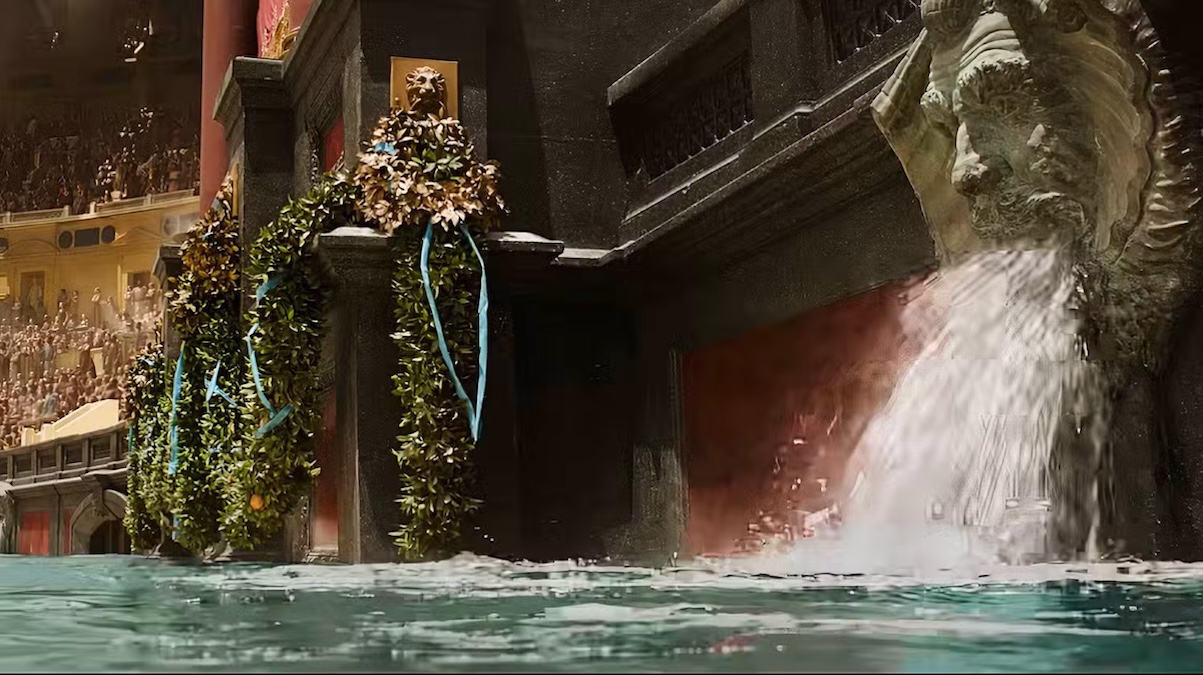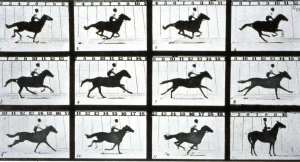
This article contains Gladiator II spoilers.
“Filling the Colosseum with water looks silly,” one friend said months ago after the first trailer for Gladiator II dropped. “Why are there battleships in the arena?” asked another while watching the scene where Paul Mescal’s Lucius manned an oar and dodged arrows before the mob of Rome. Yet as you have likely heard by now, the Romans really did stage miniature naval battles for the citizenry’s amusement and distraction—including probably inside the Colosseum (though some still dispute the claim). Even so, there is one element in Gladiator II that does strain incredulity: the sharks.
In the same much-discussed sequence where Lucius leads fellow slaves into battle against a full-scale Roman bireme, one of his compatriots has the bad luck to take an arrow to the side. While the volley might not have killed him, falling into the water and immediately being pulled under by a toothy leviathan sure did. Unfortunately for the hapless meat sack and many others like him, here in Ridley Scott’s arena, there be sharks.
It’s a moment that has left folks wondering whether the Romans really placed man-eating fish in the most famous ancient ruin in the world—and it’s left Scott also ready with a characteristically taciturn defense: “Dude, if you can build a Colosseum, you can flood it with fucking water,” the director told Collider. “Are you fucking joking? And to get a couple of sharks in a net from the sea, are you kidding? Of course they can.” It’s an interesting argument, although one not necessarily rooted in history. With that said, the spectacle of men fighting and dying against watery beasts has more of a foot in reality than you might expect…
Yes, They Flooded the Colosseum
Not only do several Roman historians from antiquity assert that the Colosseum was flooded for “naval battles,” but even these were the byproduct of Roman emperors wishing to adapt the capital’s new amphitheater in the style of a bloodsport more popular than the gladiatorial games. In fact, while nearly every movie and TV show about gladiators includes the line, “Those who are about to die salute you,” being uttered in the emperor’s presence, the phrase was only recorded once in history: before the Emperor Claudius during his mock naval battle on Fucine Lake in 52 A.D. where allegedly 19,000 combatants took to “the sea” in 100 warships. This is at least what comes down to us from the Roman historian Suetonius, who recorded the scale of the spectacle decades later (he was not born when it actually occurred).
Whether exaggerated or not, the enormity of Suetonius’ description of the event underscores how grand these mock naval battles, or Naumachia (Ancient Greek for “naval combat”), were. Decidedly more expensive and bloody than the mere skirmishes of gladiatorial combat, a naumachia was the equivalent of a nine-figured blockbuster that only came around on special occasions to really wow the crowd.
The first known naumachia is recorded to have occurred in 46 B.C. in honor of Julius Caesar after his return from Egypt and victory over Pompey Magnus and the other Republican forces. As part of his triumph, a basin was dug near the Tiber River where 2,000 combatants and 4,000 rowers—all prisoners of war—were condemned to fight to the death in full-scale Roman triemes and biremes. His eventual successor, the first official Roman emperor Augustus, recorded on his own tomb’s monumental inscription an account of a grand naumachia even greater than Great Uncle Julius’. Augustus boasted that he saw 3,000 men (not including rowers) fight in 30 ships in an even larger basin that was constructed by the River Tiber.
So there was a history of naval combat being a cherished pastime before the Roman Colosseum was even built in the first century A.D. Which is perhaps why getting such bloody water shows into the tinier space became a point of pride among the emperors and the historians who remembered them. The Roman historian Cassius Dio tells us nearly a century after the fact that the Emperor Titus put on a naval battle of some kind in the Colosseum during its inaugural year in 80 A.D. Five years later, his sadistic heir, the Emperor Domitian, staged another sea battle in the Colosseum.
Some engineers and historians dispute the assertions due to debate over how the Colosseum could be successfully flooded. Their counterargument comes down mostly to the likes of Dio being mistaken.
No, They Didn’t Have Sharks. But There Were Crocodiles…
Despite Mr. Scott’s blunt assertions, there is no evidence that a shark was ever used to fight gladiators. However, crocodiles represented one of the most popular and exotic creatures to be “celebrated” during the games in the century which saw Rome transition from republic to empire. And like most objects of fascination for Romans, they were celebrated by the crowd watching them die.
While most learned Romans would know what a crocodile was, with the exotic beast capturing the imagination of many in the Greco-Roman world after the Greek historian Herodotus traveled to Egypt in the fifth century B.C., Romans experienced their own century-long era of Egyptomania following first Julius Caesar’s adventures on the Nile and then Octavian (later renamed Augustus) essentially securing his emperorship by defeating Mark Antony and Cleopatra and assimilating Egypt into the Roman Empire in 30 B.C.
Beasts from the edges of the empire proved a popular source for “hunting games” or venationes. A venatio was a special type of spectacle during Roman games/circuses where condemned men, captives, or, yes, gladiators were expected to battle against strange beasts from faraway lands. In a way, it spoke to the breadth and astonishing mystique of the empire’s reach when creatures like lions, panthers, or ostriches were brought into an amphitheater and forced to fight men to the death in front of a cheering crowd. And in the case of Egypt, the exotic creatures most popularly brought to Rome were crocodiles and hippopotamuses.
As many as 11,000 animals could be killed in a single “game” or hunt, and the crocodile had special meaning in these spectacles because Romans were taught (mostly by their Greek imperialist predecessors) to sneer at some Egyptian deities with their animal heads, including Sobek, the crocodile-headed god who was associated with the Nile and the threat of chaos. (Notably, however, the Romans did assimilate the worship of the Cult of Isis from Egypt.)
For the Colosseum—which was completed 150 years after Cleopatra’s death—there are accounts of gladiators being forced to battle crocodiles to the death in the sand. Think a bit like what we saw with tigers in the first Gladiator and the rhinoceros in Gladiator II. However, there are accounts of water shows where men in boats were tasked with hunting crocodiles similar to what occurs in Gladiator II. During the late reign of Augustus in 2 B.C., we are told that 36 crocodiles were hunted in a specially designed pool made within Rome’s Circus Flaminius, a structure originally built several centuries earlier for chariot racing.
So yes, chariot-racing arena was retrofitted into a giant pool where men were handed spears and in small boats tasked to “battle” crocodiles, which honestly still sounds fairly one-sided. However, I cannot find an account of crocodiles being used during a naumachia (naval battle) whether in the Colosseum, Circus Flaminius, or otherwise.
But if you tell a Hollywood screenwriter that “naval combat” was a popular spectacle in the Colosseum—as was crocodile battling, whether without water in the Colosseum or with it in another manmade structure—it is not hard to imagine someone saying “let’s combine them for maximum spectacle!” And then, perhaps, a British director shrugging, “Why not sharks?”
Gladiator II is in theaters now.
The post Gladiator 2: The Colosseum Never Had Sharks, But There Are Crocodiles in the Real History appeared first on Den of Geek.





